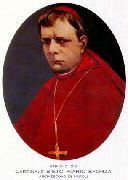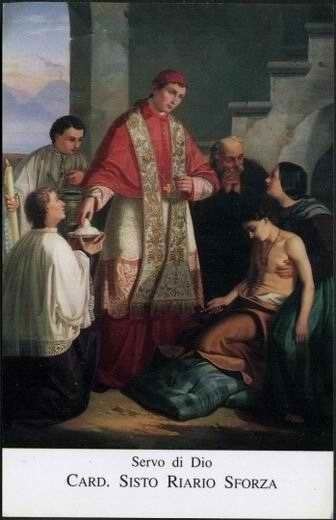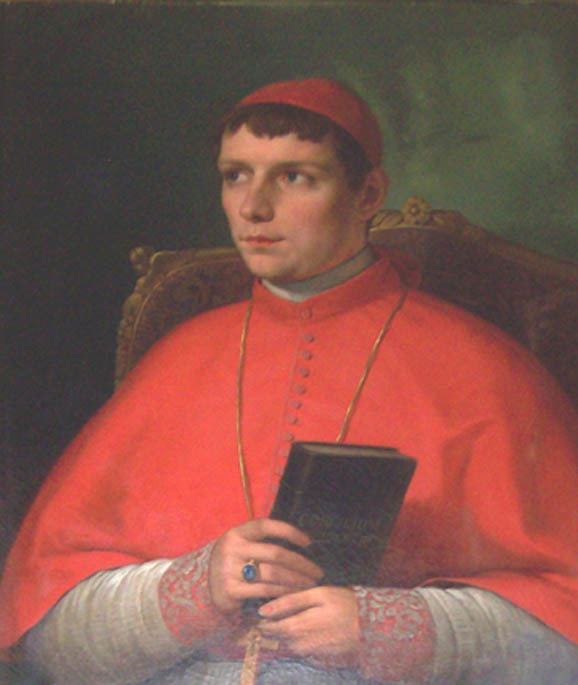Rank Cardinal-Priest Ordination September 1, 1833 Consecration May 25, 1845 | Name Sisto Sforza Birth name Sisto Riario Sforza | |
 | ||
In office 24 November 1845 - 29 September 1877 Born December 5, 1810Naples, Italy ( 1810-12-05 ) Previous post Bishop of Averso (1845)Camerlengo of the Sacred College of Cardinals (1865-1866) Archdiocese | ||
Sisto Riario Sforza (5 December 1810 – 29 September 1877) was an Italian cardinal of the Roman Catholic Church and Camerlengo of the Sacred College of Cardinals.
Contents

On Thursday 28 June 2012 Pope Benedict XVI, in an audience with the Prefect of the Congregation for the Causes of Saints, Cardinal Angelo Amato, decreed that the Servant of God Cardinal Sforza had lived a life of heroic Christian virtues, further advancing his formal cause for canonization and giving him the title "Venerable". Now, if a (usually medical) miracle is found to be attributable to his intercession, he can be beatified; if another is verified after beatification, he can be canonized.

Family

Sforza was born in Naples, Italy and belonged to the noble House of Riario-Sforza. He was the son of Giovanni Antonio Riario Sforza and Maria Gaetana Cattaneo della Volta.

Sforza was a nephew of Cardinal Tommaso Riario Sforza who announced the election of Pope Pius IX and who also held the position of Camerlengo of the Sacred College of Cardinals 35 years before his nephew from 1828 to 1830. Other cardinals belonging to his family were Pietro Riario, O.F.M., Raffaele Riario and Alessandro Riario.
Education

Sforza was educated at the Roman Seminary, Rome, the Pontifical Academy of Ecclesiastical Nobles, Rome and La Sapienza University, Rome. He obtained a Doctorate in Theology by apostolic brief on 23 April 1845. On 1 January 1825 he received the ecclesiastical habit, followed by the clerical tonsure on 13 February 1825. Minor orders were received on 25 December 1826, subdiaconate on 21 April 1832 and he was ordained a priest on 1 September 1833 by Filippo Giudice Caracciolo who he later replaced as Archbishop of Naples.
Vatican service
He worked for many years as privy chamberlain of the pope and was made abbot commendatario of S. Paolo in Albano and vicar of the cardinal camerlengo in the school of S. Maria in Via Lata Abletgato. He also was canon of the patriarchal Vatican basilica and private secretary of the pope in 1841.
As secretary of memorials, Sforza accompanied Pope Gregory XVI on his trip to Umbria and Rieti in 1842. He contributed to the conversion to Roman Catholicism of count Stackelberg and prince Galitzin. King Ferdinando II of the Two Sicilies proposed him to the pope to occupy the see of the Bishopric of Aversa, which he did on 24 April 1845.
Sforza was made Assistant at the Pontifical Throne on 17 May 1845 and was promoted to the metropolitan see of Naples on 24 November 1845. He was made a cardinal-priest in the consistory of 19 January 1846 with dispensation for having an uncle who was a cardinal. He received the red hat (symbol of a cardinal) and the title church of S. Sabina on 16 April 1846. He participated in the Papal conclave of 1846.
Exile
Sforza was forcibly exiled after the collapse of the kingdom of the Two Sicilies, September 1860 to July 1861 and 1862 to 1866 and also participated in the First Vatican Council, where he spoke out against the decision to proclaim the Dogma of papal infallibility.
Death and beatification
He died on 29 September 1877 in Naples and was exposed and buried in the metropolitan cathedral of Naples.
Pope Leo XIII had said that he would not be elected pope with Cardinal Riario Sforza alive. Sforza died in 1877 and Leo XIII was elected the following year in 1878.
The informative process for his beatification started in 1927 in Naples and the canonical process in Rome in 1947. Pope Benedict XVI declared him to be Venerable on 28 June 2012.
